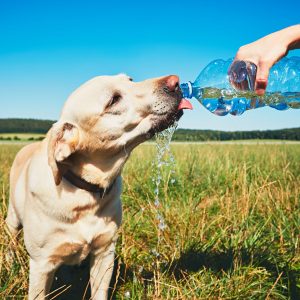National Heat Awareness Day
May 31st is the National Weather Service’s National Heat Awareness Day and this is perfect timing for us to remind you to be careful out there! The heat is something that we are all too used to here in south Texas but somehow we still forget how heat plus humidity can cause heat stroke in pets. Pets don’t sweat out excess body heat like humans, and because of that your pet relies on panting to expel heat. There are times however when panting does not do enough to cool your pet down.
somehow we still forget how heat plus humidity can cause heat stroke in pets. Pets don’t sweat out excess body heat like humans, and because of that your pet relies on panting to expel heat. There are times however when panting does not do enough to cool your pet down.
Heat Exhaustion and Heat Stroke
We see more heat exhaustion and heat stroke in dogs but it can certainly happen to cats as well. Heat Exhaustion occurs when your pet’s body temperature becomes elevated above the normal temperature. Temperatures over 103°F are considered above normal. If your pet’s temperature reaches 106°F or higher, your pet is in danger of having heat stroke.
During heat stroke organs can begin to shut down and the heart can stop. Heat is a potential problem that cannot and should not be ignored.
Warning Signs
Watch for the warning signs of your pet becoming overheated:
- Excessive panting
- Collapse
- Convulsions
- Vomiting
- Diarrhea
- Gums that are blue or brick red
Some more subtle warning signs include:
- Confusion and not responding to commands as usual
- Glazed eyes
- Excessive drooling
- Rapid heart rate
- Fever
- Lack of coordination or dizziness
- Lethargy
- Loss of consciousness
Risk Factors
With the right conditions, all pets can be at risk of overheating. Some pets are much more prone to it however because of their anatomy. Pets with long hair, thick coats, very young pets, very old pets and brachycephalic dogs and cats are at higher risk. Brachycephalic pets include dogs and cats with short, flat faces like Persian cats, pugs or bulldogs. Other pets that are more susceptible are overweight pets, and pets who have heart or lung problems.
If you have a pet that is an active breed with a normally high energy level and lifestyle, you may need to be extra cautious with them. These pets, especially dogs may push themselves too hard so it is up to you to make sure that they don’t. Be sure they are not outside too long; make sure they takes lots of breaks and have access to plenty of water.
Right now our temperatures are not that high but our humidity is and that adds to the danger. When it is humid outside be extra vigilant with your pets because it is harder for them to cool off.
What To Do If Your Pet Becomes Overheated
If your pet is suffering from the symptoms of heat exhaustion get him out of the heat and to a cooler place immediately. Somewhere indoors with air conditioning is the best place to move your pet.
Check your pet’s temperature. Anything above 103°F, check with your veterinarian. If the temperature is above 106°F, seek emergency help immediately. You can place lukewarm towels on his neck, armpits and groin area. You can wet his paw pads with cool water or rubbing alcohol and offer him water to drink. Do not force him to drink and DO NOT cool your pet too quickly, as doing this can lead to shock.
Prevention
The best plan is to avoid the situations described above. You can accomplish this by walking your dog in the morning and evening when it is cooler outside. You should never, ever, ever leave your pet in a parked car!!! Even in the shade with windows cracked, it is still too hot for your pet to stay comfortable or safe. Temperatures can reach 120°F in minutes, turning your car into a death trap.
We want you and your pet to have fun in the sun and enjoy the outdoors but we want you to be safe. As always, call us with questions at 210-695-4455.
